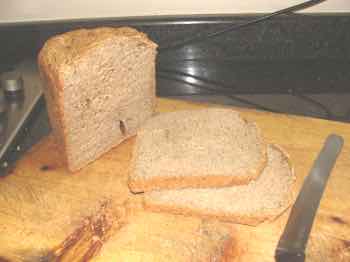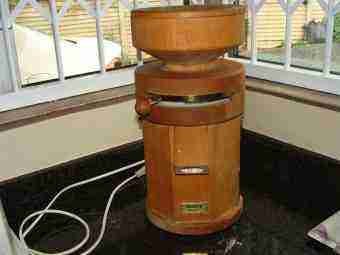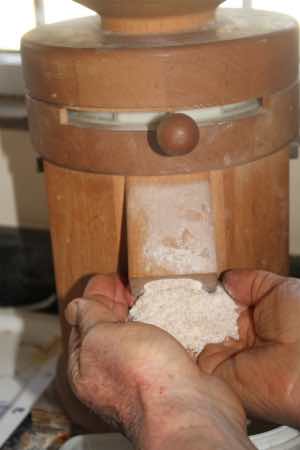- Bernard Preston homepage
- Bread
- Low Gi Bread
Low GI bread
Low GI bread takes less than five minutes of your time using a basic machine that kneads and then bakes the dough.
Our daily loaf has since the early mists of time been a staple in the diet of human beings and is likely to remain so despite some doubts about just how nutritious it is.
Those concerns are centred on two basic concerns. Firstly the way in which it is baked today; it is a totally different product from what our forefathers described as "the staff of life."
And secondly it needs to be viewed in the context of the whole meal. Our forefathers were not obese like modern man is; they could eat their bread with relish and none of the doubts we may now have.

This page was last updated on 9th September, 2023.
Certainly it is high in carbohydrate and if you have a problem with blood sugar then you may well be concerned with the amount and kind of loaf that you enjoy.
Let us get it over with; white bread and rolls may melt in the mouth and taste divine but they rank amongst the very worst of junk foods that we can eat.
Keep them for high and holy days and when dining with friends whom you do not want to offend with pious remarks of what you do and do not eat. Enjoy them daily and they will make you sick, obese and a great risk of diabetes.
The main concern with bread is how quickly it is turned into sugar in the blood stream; enter some understanding of the term glycemic index. Some foods, which include your favourite loaf, white rice and cold-storage potato are turned very rapidly into glucose if eaten on their own.
Let me say that again; enjoyed in isolation, many carbohydrates have a very high glycemic index. We need to look at the context of the whole meal rather than one particular food.
Adding fibre, fat and protein when baking your bread radically changes how quickly it is digested and turned into sugar.
Even whole wheat from the supermarket has a fairly high glycemic index, due to the refining, but because of its inherent fibrous bran, it is digested more slowly than white bread. Add butter, cheese or a slice of ham, and a leaf of lettuce and you have a quite different kettle of fish.
Since the onset of the skimpy carbohydrate diets for the obese, manufacturers have found to their dismay that their sales have dropped; enter low glycemic index bread.
As a general rule, the glycemic index of a food can be lowered by grinding it less finely, and adding fibre, protein and fat.
One slice of real bread is enough carb at a single meal; more and you will feel stuffed. It's that filling; satiety is the word.
Or, to put it differently, remove the fibre, fat and protein from a food, and then grind it very finely, and you have just turned nutritious wholewheat into cake flour that is totally detrimental to your well-being.
Sugar cane and beets are good for health and have no detrimental effect on the teeth. Extract the the fibre and phytochemicals, refine it and you have a junk food; pain and visits to the dentist become the norm.
Remove the bran from flour because the public wants fine white loaves; extract the fat as otherwise the wheat germ oil will go rancid.
Extract the the wheat germ because the pig farmers will pay a high price for it; grind it finely and, bingo, you have the worst of crappy foods sold in your local supermarket.

There is a relatively simple solution to all this. Bake your own loaf, using a bread machine. It's cheaper than supermarket low GI, and you can control the ingredients.
The only part that is difficult is that the purist will grind his own flour, because the fatty fraction starts being oxidised the moment you crack the kernel. For the rest it is merely a matter of adding the ingredients, and keeping out the enzymes, emulsifiers and preservatives that the manufacturers utilise to hasten the process and give it a shelf life.
Bake your own low glycemic index bread and you need have none of these concerns, bar how long the flour has been on the shelf.
To make the perfect loaf you would also need a wheat grinder but, even without your own freshly ground wheat, you are still streets ahead of any bread sold in the supermarket.
Expressed in different terms, the starch in 100% wholemeal is called resistant; instead of being digested in the small intestine, producing a surge in blood glucose, much passes through to the colon where instead it is fermented by the microbiota.
Read more about resistant starch.
The first step then is to add some protein to your dough. Manufacturers of low glycemic bread would add soy flour.
I do not have a problem with that, only I personally dislike soybeans.
So instead, I add a healthy dollop of homemade hummus which I prefer. In truth, both soybeans and chickpeas are legumes, rich in fibre, protein and fat; it is a matter of choice. The latter are cheap, readily available, and easy to process.
Secondly, you can add the fat of your
choice. Olive oil tops my list and I often add a little butter because
of all the choice healthy foods we eat. We have quite normal cholesterol; in
fact, it is low. Coconut is good too.
Low GI bread
Low GI bread takes less than five minutes of your time using a basic machine. Then you have complete control of the ingredients; the supermarket loaf has double the salt and is loaded with chemicals that make it taste dreadful; that is why you need all that polony and jam.
Supermarket low GI bread would have one of the polyunsaturates like soyabean or sunflower oil. There is nothing wrong with that, only we already get too much of them, raising the ratio of polys to monos, and that means inflammation in the body; and hence my interest as a chiropractor.
Inflammation means neck and back pain, polymyalgia and angry linings of the arteries and the alimentary canal.
Rather add olive oil which consists mainly of monounsaturated fatty acids; and a little butter. Remember that heart disease has only been around for about one hundred years. It arrived after the change from high animal fats to margarine. Chances are that your forefathers didn't die of heart disease unless they smoked. Margarine contains toxic hydrogenated fats.
Basic Bread recipe
Do not get me wrong; there is something very satisfying about kneading and baking your own loaf; and nobody describes it better than Jamie Oliver at his own basic bread recipe page.
It is the way I baked bread and rolls for years.
So why do I not build a page with my own basic bread recipe? Because this site is about healthy food made fast; kneading your own dough needs to be done in a leisurely and time consuming way. Something that puts most of us off baking our own loaf.
The bread machine is no quicker, or longer; both methods require five hours. But the time you spend is a tenth. Less than ten minutes against an hour, or longer whilst waiting for the dough to prove and rise.
There are two more reasons I like the bread machine. The only washing up is the measuring cylinder and the teaspoon for the honey and hummus. There is a skivvy lurking behind Jamie that he does not tell you about; cleaning up is a schlepp in my book.
The other is that you do not have to heat a whole oven which draws at least two kilowatts; your bread machine uses a quarter of the energy, and you can easily run it on your solar generator; it's green friendly.
If you have lots of time to kill, don't mind washing up and have plenty of money for more electricity, then kneading your own bread is very therapeutic. If not, it is our low GI bread recipe.
Either way you will quickly learn the difference between real and fake bread; the one from your own kitchen and the bland, tasteless loaf sold in the supermarket.
Potato cooking water
Here's a little tip. Use the water you have used to cook potatoes in the dough; it will rise much better and improve the texture of your loaf.
Anti-inflammatory omega
Anti-inflammatory omega 3 is what keeps arthritis at bay; add freshly ground flax seed for more fibre, lowering the glycemic index yet further.
Then you want to add fibre to your low GI bread. Bakers add smart bran but it adsorbes calcium in your food, reducing absorption; in particularly that is not good for women. Rather I would recommend various seeds and nuts. I make sure one of them is freshly ground flax for its high anti inflammatory omega 3 content.
- Sunflower
- Pumpkin
- Poppy
- Pecan
- Freshly-ground flax
Each of these has its own merits but in general they are high in fibre, have some protein and the healthy fats; and no trans fatty acids which you are likely to get in your supermarket low GI bread.
Basic panera bread menu recipe
I am not exaggerating. It takes me no more than five minutes to measure out the ingredients for our panera bread menu recipe; flour and water, the yeast, the honey, salt and olive oil. Then to turn it into low GI simply add a dollop of hummus and a lump of butter; crack three pecan nuts and add them together with the seeds.
Butter is back by the way.
Five hours later you have a divine loaf of low GI bread for lunch. It has probably fifty times the nutritional value, hundred times the taste, no chemicals and for half the price of a supermarket loaf of low GI bread; that's a bargain!
Easy sourdough recipe
Easy sourdough bread recipe is my favourite; this is the one I bake most often now.
It is also a low GI loaf.
A quite different flavour can be obtained by making your own easy sourdough bread recipe. Even gluten intolerant folk tolerate it far better as the lactobacillus breaks down the problem child, proline, a particularly stable amino acid that is not well digested often leaving unhealthy protein fragments that are problematic if you have a leaky gut.
Read more about this complex subject and come to grips with the meaning of gluten. You too could probably enjoy sourdough bread if you're willing to prepare the dough and bake your daily loaf; it takes only five minutes after all.
Hummus
Hummus gives the added protein and healthy fat that lower the glycemic index of your low GI bread; make it yourself. For greater understanding of this complex subject, read more at what is starch in food?
Notes about the added ingredients
- Grinding your own healthy flour is a major step up in baking your bread. It rises better and you will no longer need to buy omega-3 and vitamin E capsules. It is very little extra time but good quality grinders do not come cheap. This home bake bread flour page tells more.
- It takes me only five minutes to make hummus, the main protein that I add to our homemade bread, if you have the chickpeas precooked and frozen. Authentic hummus recipe is as easy as pudding n pie.
- Another way to lower the GI by adding more protein is to make this kefir sourdough bread; the probiotics mean better tolerance of the gluten.
- It takes me one minute to crack three pecan nuts. Either shell them yourself, or get them from a vacuum packed container. The oils oxidise very quickly; they go rancid.
- Your flaxseed must be freshly ground. It is also the richest vegetable source of omega-3 and is oxidised very rapidly. Hence its value as an anti oxidant; add them as late as possible as it inhibits the rising; Grinding flax seeds ...
- Although I am a fan of raw honey and use it because I am a beekeeper, I would not waste your money if I was you; once it has been baked it has little merit over supermarket honey. It is vastly important to know the difference between simple vs complex carbohydrate.
Do you have a weight problem? Then eat only low GI bread, and limit even that. Try smearing olive oil instead of butter, but never margarine onto your bread if you are having something like a slice of ham on it.
Enjoy!
Refined grains and depression
What we eat plays an important role in depression and mental illness in general, says the South African Depression and Anxiety group. In particular those foods that promote inflammation in the body are thought to trigger the pathways to the parts of the brain responsible for depression.
The group recommends unrefined grains such as used to make our low GI bread, fatty fish and lean meat; and poultry. They also recommend legumes, fresh fruit and vegetables; in short no refined carbs.
Is whole wheat flour the real deal?
 No separation of the three streams
No separation of the three streamsAlas, it is certainly not. The millers may call it wholewheat flour provided it contains at least 60% of the grain. That removed of course is the wheat germ, vitamin E and the fatty acids that would go rancid; and much of the bran. That's where the choline is found. It is one of the very important B complex that the average Western diet has less than 50% of the required daily amount; a higher risk of birth defects is one of the consequences.
Worse still is that commercial wholewheat bread has the same glycemic index as the white loaf[2].
But research published in JAMA reveals that adding smart bran to a refined flour diet has little benefit.The only solution is freshly-ground true wholemeal.
- Choline food sources
- What is artisan bread?
- Whole wheat vs whole grain. Web: https://tinyurl.com/yhmm2xdr
When browsing use right click and "Open Link in New Tab" or you may get a bad gateway signal.
Newsletter
Our newsletter is entitled "create a cyan zone" at your home, preserving both yourself and Mother Earth for future generations; and the family too, of course. We promise not to spam you with daily emails promoting various products. You may get an occasional nudge to buy one of my books.
Here are the back issues.
- Lifestyle and ideal body weight
- What are ultra-processed foods?
- Investing in long-term health
- Diseases from plastic exposure
- Intensive lifestyle management for obesity has limited value
- A world largely devoid of Parkinson's Disease
- The impact of friendly bacteria in the tum on the prevention of cancer
- There's a hole in the bucket
- Everyone is talking about weight loss drugs
- Pull the sweet tooth
- If you suffer from heartburn plant a susu
- Refined maize meal and stunting
- Should agriculture and industry get priority for water and electricity?
- Nature is calling
- Mill your own flour
- Bake your own sourdough bread
- Microplastics from our water
- Alternative types of water storage
- Wear your clothes out
- Comfort foods
- Create a bee-friendly environment
- Go to bed slightly hungry
- Keep bees
- Blue zone folk are religious
- Reduce plastic waste
- Family is important
- What can go in compost?
- Grow broad beans for longevity
- Harvest and store sunshine
- Blue zone exercise
- Harvest and store your rainwater
- Create a cyan zone at your home
Did you find this page interesting? How about forwarding it to a friendly book or food junkie? Better still, a social media tick would help.
- Bernard Preston homepage
- Bread
- Low Gi Bread
Address:
56 Groenekloof Rd,
Hilton, KZN
South Africa
Website:
https://www.bernard-preston.com